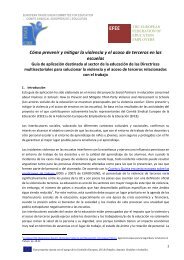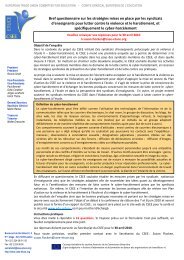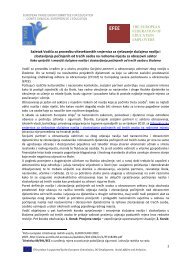Workplace Violence and Harassment: a European Picture
Workplace Violence and Harassment: a European Picture
Workplace Violence and Harassment: a European Picture
You also want an ePaper? Increase the reach of your titles
YUMPU automatically turns print PDFs into web optimized ePapers that Google loves.
<strong>Workplace</strong> <strong>Violence</strong> <strong>and</strong> <strong>Harassment</strong>: a <strong>European</strong> <strong>Picture</strong>bullying. Of those countries which have no separate legislation, only Italy plans todevelop such legislation.Even though, in many countries, there is no specific legislation on workplace violence,there is usually a more general law on safety <strong>and</strong> health or equal treatment thatcovers the different aspects of work, both physical <strong>and</strong> psychosocial workenvironment.Below, some examples of the different kinds of legislation against work-relatedviolence are presented. For a more comprehensive overview covering all EU-27countries, Albania, Norway <strong>and</strong> Switzerl<strong>and</strong> see Appendix II.A specific legal framework exists in France concerning harassment at work <strong>and</strong> sexualharassment. The law is multiform <strong>and</strong> only the basic principles of it are presentedhere.E u r o p e a n Ag e n c y f o r Sa f e t y a n d He a l t h a t Wo r kExample: FranceThe Labour Code states: ‘that no employee must be subjected to repeated deedsof moral harassment aimed at or leading to a deterioration of working conditionslikely to detract from the rights of employees <strong>and</strong> their dignity, to underminetheir physical or mental health or to compromise their professional future’ (ArticleL1152-1, Article L1152-4, 1.5.2008).The Labour Code stipulates an obligation, for the director of the enterprise, toprevent moral harassment at work by making ‘all the necessary provisions aimedat preventing activities constituting moral harassment’ (‘general obligation ofsafety’, Article L4121-1, 1.5.2008). <strong>Harassment</strong> at work can be also referenced tothe principle of non-discrimination (Article L.1132-1, 27.5.2008). The ‘Hygiene,Safety <strong>and</strong> Working Conditions Committee’ (CHSCT), present in all the companiesemploying at least 50 people, has the role of contributing to the protection ofhealth, safety, <strong>and</strong> to the improvement of working conditions of employees. Ithas to prevent risks of sexual <strong>and</strong> moral harassment.Concerning sexual harassment, the Labour Code lays down that: ‘activities ofharassment on the part of any person aimed at obtaining sexual favours for selfor for a third party are prohibited.’ (Article L1153-1, 1.5.2008). It also lays down anobligation to prevent sexual harassment (L1153-5) for the director of theenterprise, who must make ‘all the necessary provisions with a view to preventingactivities constituting sexual harassment’. The Criminal Code (Article 222-33)clamps down on the crime of sexual harassment. This offence is broadly basedon the existence of a relationship of authority. Contrary to the case of moralharassment, the perpetrator of sexual harassment can only be a hierarchicalsuperior. In civil terms, sexual harassment is punished by law (Law No 2008-496,27.5.2008).In Finl<strong>and</strong>, the Occupational Safety <strong>and</strong> Health Act No 738/2002 includes specificsections both on the threat of violence, which is preventive by nature, <strong>and</strong> onharassment, which is reactive by nature.29














